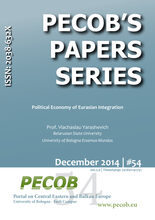and Balkan Europe
by IECOB & AIS Università di Bologna

This area collects and offers a wide range of scientific contributions and provides scholars, researchers and specialists with publishing opportunities for their research results
Political Economy of Eurasian Integration
December 2014 | #54
by: Prof. Viachaslau Yarashevich
pp: 67
ISSN: 2038-632X

Abstract
The USSR collapse in 1991 marked a new era in the Eurasian geopolitics, which was characterized by western domination and socio-economic transformation often referred to as post-communism. The cold war seemed to be over, with US and its European NATO allies celebrating the victory over the communist bloc. Russia lost its satellites not only in Central Europe, but also among many former Soviet republics, including in Central Asia. Yugoslavia was falling apart in a rapid and violent manner. Capitalism and democracy (western-style) looked as the only development option for the region. If there was a mention of integration in the mid-1990s with regard to the post-communist world, it was almost exclusively about membership in the EU, as well as in NATO (which always came first, perhaps as a security pre-condition). Apart from Belarus nobody sought to re-establish close links with Russia, which anyway was too busy with privatization and other neo-liberal economic policies that ended up in 1998 default and subsequent rise of Vladimir Putin. The evolution of Eurasian integration as an alternative integration option during post-communism was by no means smooth, yet it did culminate in the establishment of the Eurasian Economic Union in 2015, with the Eurasian Economic Commission as its supranational governing body. Initially pushed by Belarus, Kazakhstan and Russia, the EAEU now has five full members and one candidate country, Tajikistan. Often criticized by the west as an attempt to reconstruct the Soviet “empire”, officially the EAEU seeks to emulate the 28-member strong European Union in offering its citizens and firms border-free movement, though still subject to numerous provisional exemptions. And while economically it is dwarfed by its much stronger western neighbor, the elaboration of common policies, including the industrial one, in the very first year of its existence suggests that it has the potential to become a viable development project for the region.
Table of contents
Abstract
Post-communist background
Two paths of integration in the post-communist Eurasia
The Customs Union as the core of the Eurasian Economic Union: case studies
Conclusion: political economy implications of Eurasian integration
Bibliography
Author


 Download the full paper!
Download the full paper!





